One of the easiest ways to improve your pickleball game, even if you’re a brand new player, is to start implementing simple yet advanced pickleball strategies. Leveling up your game as a beginner may actually be a lot easier than you think. The secret is to implement some effective pickleball strategies.
The five most effective pickleball strategies for any player are:
- Always hit deep on the serve and return of serve
- Aim at your opponent’s left foot as much as possible
- Minimize high shots for your opponent to attack
- Hit down the middle and to your opponent’s backhand
- Get to the net and just keep it in play
If you follow those five simple pickleball strategies, no matter how inexperienced you may be, you’ll see your team winning more games.
However, there are way more fundamental pickleball strategies that anyone can implement. The following are pickleball strategies that all advanced players use game in and game out.
But just because advanced players use them, doesn’t mean they’re complicated. In fact, the pickleball strategies I will cover in-depth today can be used by virtually any player; regardless of skill level.
To keep things simple, I’m going to break down each pickleball strategy as if we were playing through the point in a doubles game. Let’s get started.
This paddle is the most forgiving paddle I've ever played with and has a HUGE sweet spot!
Simple Pickleball Strategies For Serving
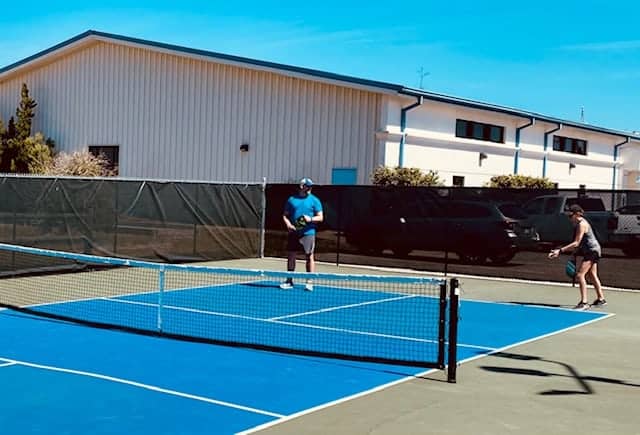
Serving Strategy #1 – Never Commit a Service Fault
I hate to be captain obvious here but, never ever commit a service fault. Any good pickleball coach will tell you to reduce the number of unforced errors. The easiest way to do that is to keep your serve simple, consistent, and in play.
Lots of beginners will try to serve with spin or serve short but most of the time the shot is inconsistent and doesn’t work. Avoid fancy serves if you’re spraying them all over the court. The best serve for a beginner is the one that lands “in” and “deep”.
That’s it. Don’t overcomplicate it.
Serving Strategy #2 – Always Serve Deep
This strategy is simple – always serve deep. One of the fundamental strategies in pickleball is to go get the net, so by serving deep, you can help drive and keep your opponent back as far as possible for as long as possible.
This can help set up a weak return, making it easy for the serving team to hit a drop shot and get to the kitchen line. The deeper the serve is the longer it takes for the return team to get to the net. This gives the serving team time to also get to the net.
Serving Strategy #3 – Force A Backhand Return
When serving, always aim for your opponent’s backhand. Returning a hard-hit serve with your backhand is much more difficult. So, force that type of shot on your opponent as often as you can.
Here’s how it works. If your opponent is right-handed, then aim for their left foot. Pepper your opponent’s left foot with deep hard serves and force a backhand return. This works regardless of which side of the court you’re serving from.
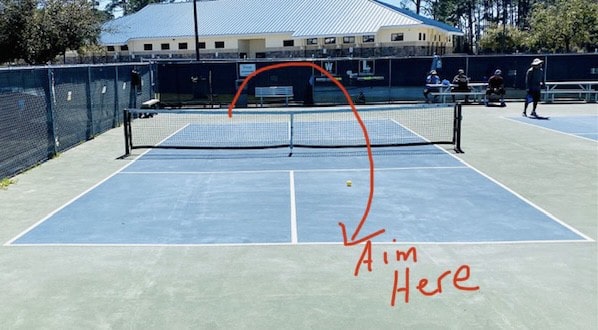
Serving Strategy #4 – Be Ready to Attack
If you’re the server’s partner, be ready! Always play back at the baseline and be ready to hit the ball. The return team does not have to hit back to the server, they can hit at you. So give yourself room for the ball to bounce and be ready!
Quick Tip: For more on the double bounce rule and why it was implemented click here.
Simple Pickleball Strategies For the Return Of Serve
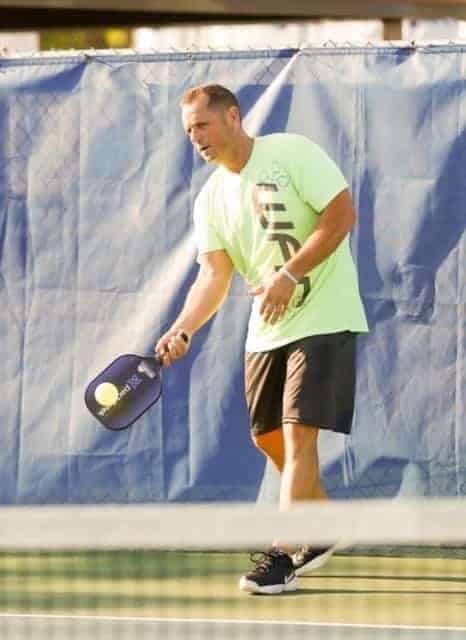
Return Strategy #1 – Always Return It “in”
Keep the return of serve in bounds. Avoid unforced errors and keep the ball in play at all costs. Don’t “gift” your opponent easy points that don’t require anything on their part.
Any pro will tell you, the return of serve should be an automatic shot. Don’t overcomplicate it, get it over the net.
Return Strategy #2 – Hit it Deep
If possible, hit the return of serve deep. Aim for the baseline the server hit from. This keeps them away from the net for as long as possible.
The deeper the return is, the longer you keep the serving back at the baseline which inherently gives you (the return team) an advantage.
Return Strategy #3 – Force the Backhand
Aim your return shot at your opponent’s left foot, forcing a backhand shot. Again, a deep backhand shot that lands by their left foot makes it harder for the service team to execute a drop shot. Like I said above, this tactic works regardless of which side the serve comes from.
When returning the serve, aim at your opponent’s left foot – forcing a backhand shot.
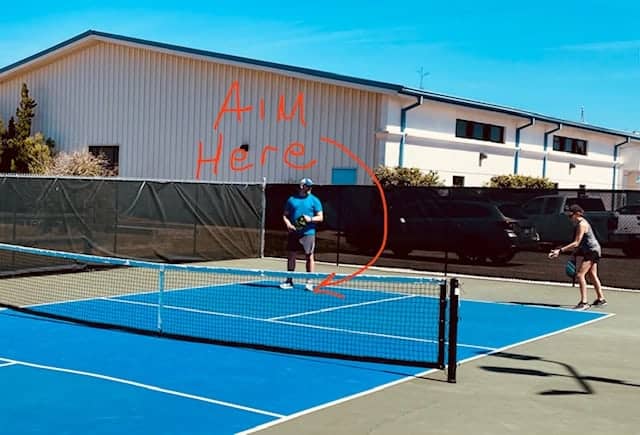
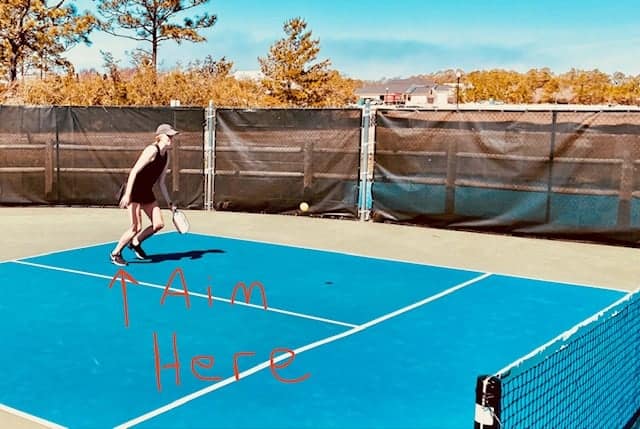
Return Strategy #4 – Aim Down the Middle
If you can’t hit at your opponent’s left foot, aim down the middle over the center of the net. The lowest point of the net is in the middle so aiming for the low points helps shots get over the net. And, shots hit down the middle can cause confusion for the service team.
If the ball is hit cleanly, right down the middle of the court, and the serving team doesn’t call out whose ball it is, then you’re most likely going to win the point.
Aiming low and down the middle is never a bad idea.
Return Strategy #5 – Combine Strategies
The third shot drop is the ideal shot for the serving team’s next hit, so make it difficult for them to set up by combining the above strategies. Especially #2 and #3.
Hitting it deep and at your opponent’s left hand is the best way to force a difficult third-shot drop. A third shot drop is already a difficult shot to begin with, but attempting one after a shot that is deep and to the backhand makes it exponentially more challenging.
Quick Tip: For more on where to specifically stand in pickleball, read my helpful guide here.
Simple Pickleball Strategies For The Third Shot
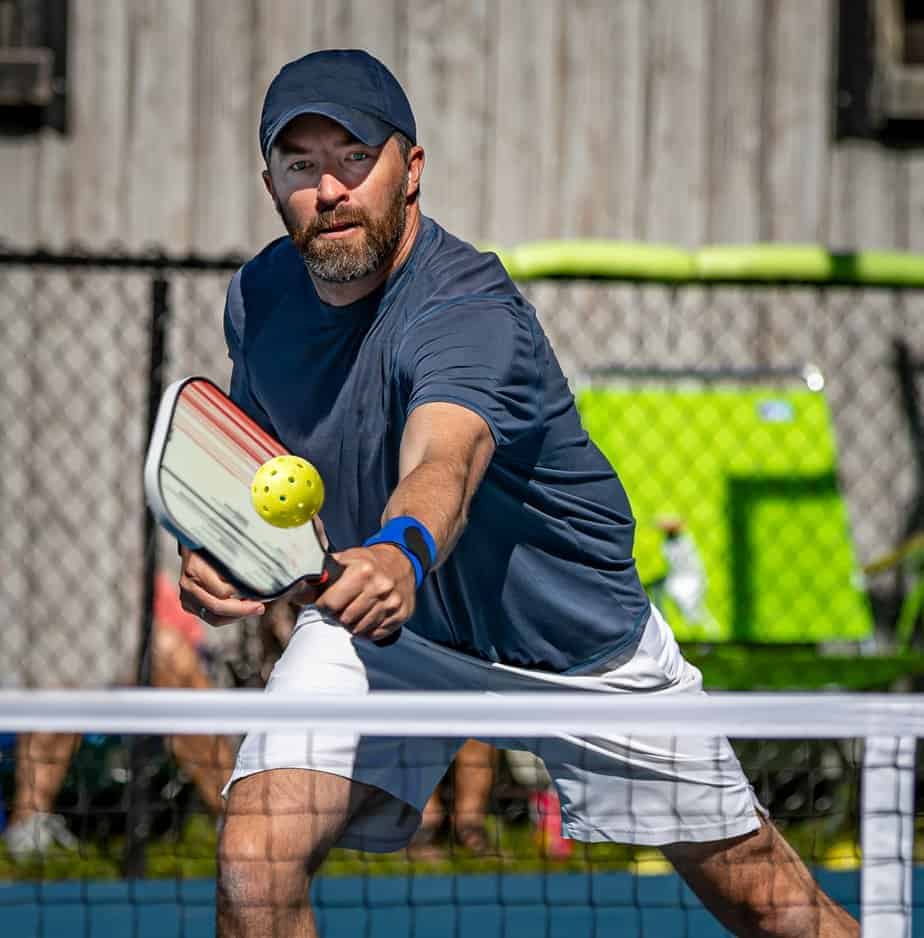
Third-Shot Strategy #1 – Keep it Low
The third shot in pickleball is crucial for the serving team! So, it’s imperative you get it right! The trick to any third shot is to keep the ball down or low. This is because your opponents will most likely already be at the no-volley zone line.
If you hit it high, it’s going to get put away and the point is over. High third shots do you no good.
Third-Shot Strategy #2 – Don’t Hit an Attackable Ball
If your opponents are at the net, the worst thing you can do is hit what 5.0 player Dave Weinbach calls an “attackable ball.” Attackable balls are generally hit low too high – effectively teeing up a ball for your opponent to “attack” on.
To illustrate this, take a look at the series of pictures below. These are third-shot drops hit at me. The first is hit way too high, I’m going to blast it back. This is an attackable ball. The second is a little better, it’s lower and forces me down but it’s not forcing a true backhand.
The third pic illustrates where the ball should be to force a backhand volley, but again it’s relatively high and I’m not out of position. The fourth picture shows the ideal shot. It’s low, not attackable, and is absolutely forcing me out of position to reach for a backhand ground stroke across my body.
The last pic illustrates a tough shot for a lot of players to get back over the net. This is the strategy you want!
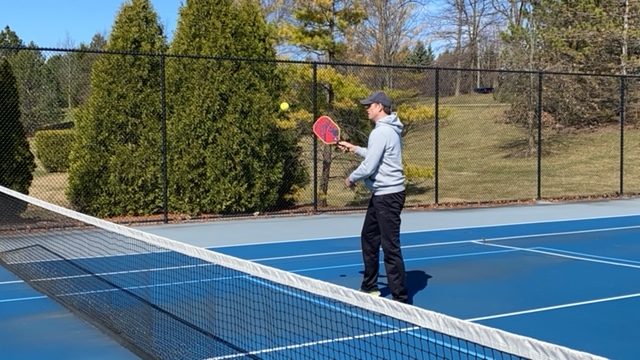
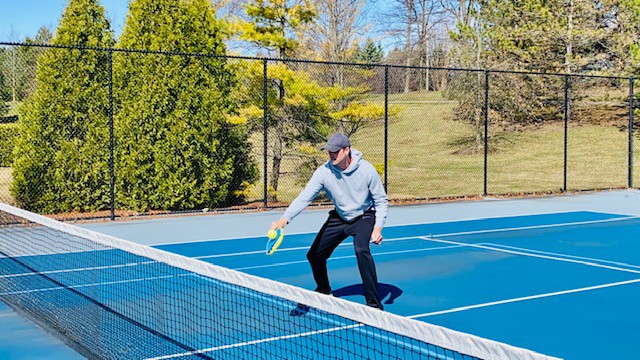
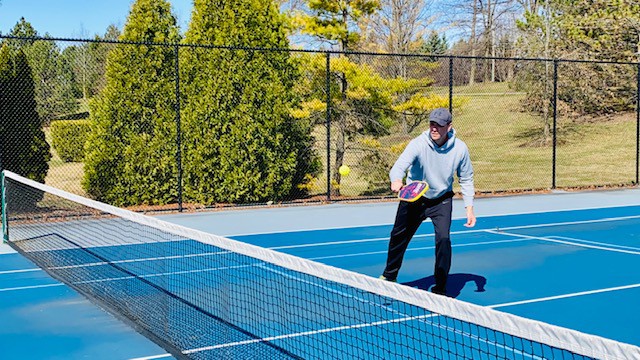
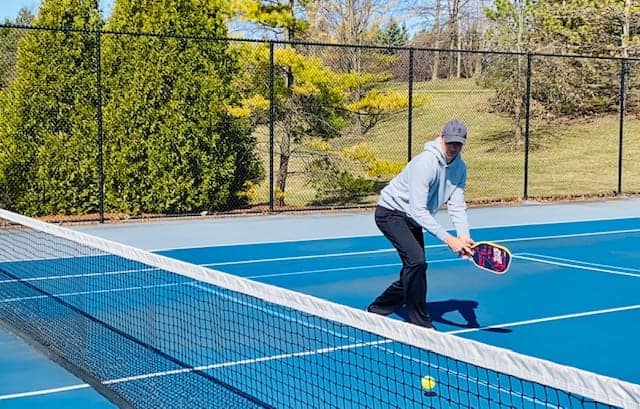
Third-Shot Strategy #3 – The Drop Shot
The best third shot is the drop shot. This is a shot that has its highest arc point on your side of the net and drops lightly into the no-volley zone. This can be a challenging shot, especially if the serving team is still back at the baseline and your opponents are at the net.
Be patient, this shot requires a lot of practice. For a thorough walk-through of the process, my friend Barrett created this helpful guide.
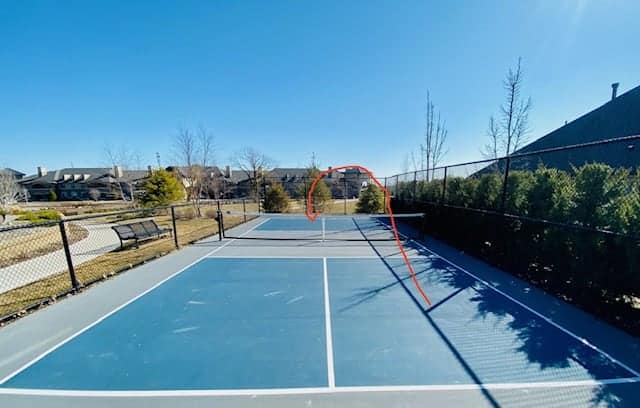
Reference the pic above – When hitting the third shot drop to the far end of the court, aim right where the arrow is pointing in between your opponents with the ball just slightly on the inside left of your opponent’s court.
The ideal drop shot should land in the kitchen area but this will take practice so be patient.
Third-Shot Strategy #4 – The Third Shot Drive
If your opponents are at the net, and an effective third-shot drop is not in your arsenal of shots yet, then the next best shot is to hit what is known as a “drive shot” at your weakest opponent’s left foot.
This is where you drive the ball low over the net with speed and power, forcing the weakest opponent to hit a difficult backhand.
Third-Shot Strategy #5 – Drive Down the Middle
Another drive shot option is to hit the same type of shot but down the middle. When hitting down the middle, aim for your opponent’s left foot if they’re on your left side or the right foot of the opponent lined up on your right side.
This forces your opponents to decide whose ball it is (confusion is a good thing) and it also forces only one player to get a forehand on your ball (the player on your right if he or she is right-handed).
Indecision and hesitation are your friend here so take advantage of it.
Third-Shot Strategy #6 – Soft and Low
If a drive shot or a drop shot is not available to you, the safest strategy here is to just hit the ball down the middle as softly as possible with little to no arc.
Soft shots are great in pickleball but if they’re too high, they can be smashed back at you.
Third-Shot Strategy #7 – Aim At the Deepest Opponent
The final scenario to cover here is if your opponents are not at the kitchen line. If you’re hitting the third shot, and one or both of your opponents are not at the kitchen line, then aim for the feet of the opponent who is furthest back.
Hitting at the opponent who is positioned the furthest back keeps your opponent away from the kitchen line long. This gives the serving team more time to get to the net. And hitting at someone’s feet forces them to back up in order to hit it back.
Simple Pickleball Strategies For Dinking At The Net
Dinking Strategy #1 – Hit Low Over the Net
My number one dinking strategy when at the net, is to always to keep the ball as low as possible. Keeping the ball low, keeps your opponent from attacking. This may sound simple but it’s a fundamental strategy in pickleball no matter what skill level you are.

Dinking Strategy #2 – Play it Safe
My second dinking strategy is to dink safely. Don’t overcomplicate it. Play it safe and hit high-percentage shots that keep the ball in play.
Many new players get in trouble when they think they have to get fancy with a dink shot and put spin on it. Watch the pro players dink. They keep it simple and soft. That’s it.
Dinking Strategy #3 – Hit High to Low
Hitting high to low is ideal when at the net. This allows you to play more aggressively and put points away. Hitting low to high is not ideal. This tees up an “attackable ball” for your opponent.
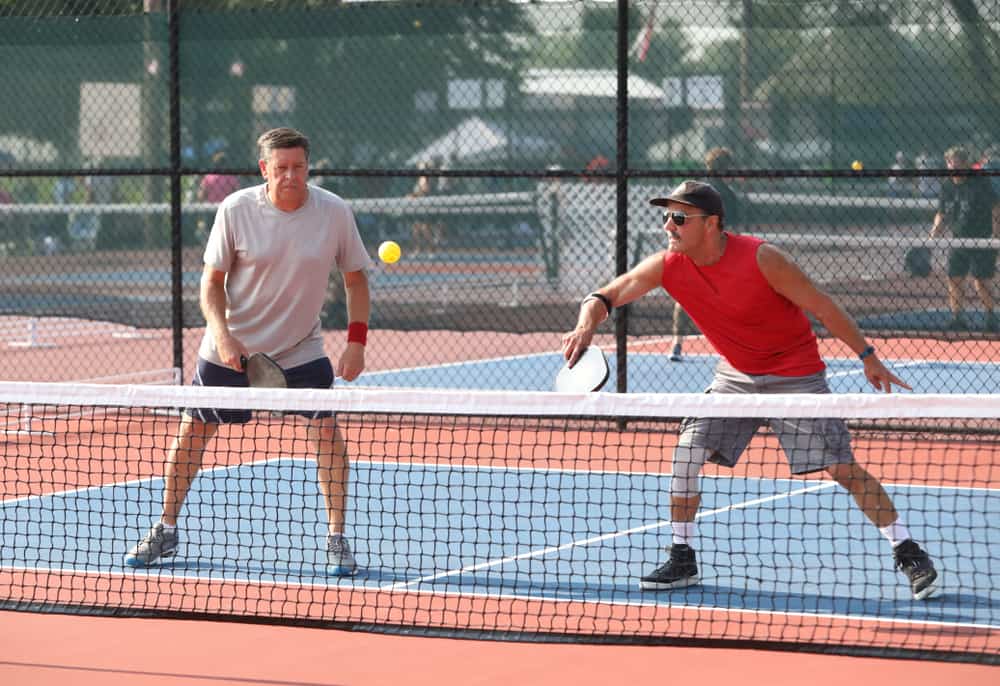

Let’s take a closer look at the pic above. This ball is forcing me to hit “low to high” and with a backhand. This is the ideal shot! If you’re at the net, force your opponent into this kind of dink.
Dinking Strategy #4 – Be Patient When Dinking
Being patient when at the kitchen line can pay dividends. To do this, hit as many low, conservative dinks as it takes for your opponent to then have to hit low to high. When you hit low, and accurate dinks long enough, eventually you’ll get an attackable ball hit at you to blast and put away.
Dinking Strategy #5 – High Point on Your Side
If you’re the one being forced to hit low to high, keep the ball as low as possible. The highest point of the ball should be on your side of the net or over the net itself. This is not an easy shot so be patient and practice.
When the apex of the ball’s arch is on your side of the net, you’ll force your opponent to have to hit up on the ball.
Dinking Strategy #6 – Hit at the Weakest Opponent’s Backhand
Like a lot of the strategies we’ve discussed, hitting at your weakest opponent’s backhand is always a good idea, even when dinking at the net. It sounds mean but it happens all the time.
Even 5.0 Pro Simone Jardim, an outstanding female player, admits that even in pro-level tournament play, the weakest player gets targeted way more.
The picture below illustrates where to aim at a right-handed player’s left foot when dinking at the no-volley zone.

Dinking Strategy #7 – Don’t Let the Bounce Back You Up
When standing at the kitchen line, try not to let the ball bounce if possible. It’s okay to move side to side, but never back up and let the ball bounce if you don’t have to.
When you back up, you’re purposefully taking yourself out of position. If you can reach the ball before it bounces, do it!
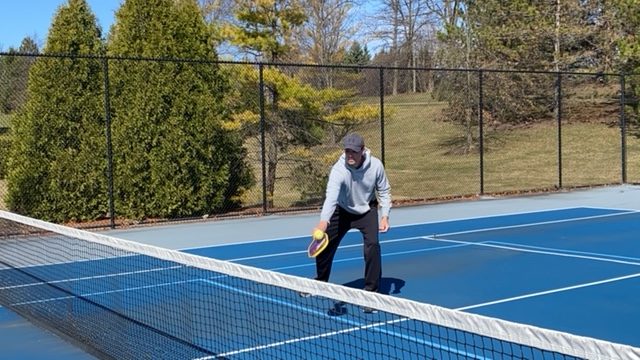
Simple Pickleball Strategies For Beginners – My Final Thoughts
I hope you found this info helpful. As you can see, some of these pickleball strategies are simple in nature – making them easy for any player of any skill level to implement. However, executing these strategies takes practice. It takes practice to hit at your opponent’s feet.
The concept is simple, but the execution takes intentional effort. The more you do it, the easier it’ll become. Probably the hardest strategy to implement of all the ones I’ve outlined is the third shot drop. It’s the game’s most difficult shot. So don’t get discouraged.
Take your time, practice it, and in the meantime try implementing the other strategies I’ve mentioned.I feel that over time, you’ll begin to see a difference and win more points. The fun part is that these pickleball strategies are ones all the pros use!
However, there is nothing overly complex here that makes them virtually impossible for beginners or developing 3.5-level players to attempt. So, just have fun with it! Give them a try, teach them to other people, and grow this wonderful game. Happy pickleballing!
Additional Pickleball Strategy FAQs to Consider
Below I explore some additional FAQs related to pickleball strategies that a lot of new players tend to ask me.
1. What are some advanced pickleball strategies to improve my game?
When looking to enhance your pickleball skills, consider incorporating a mix of pickleball strategies such as doubles strategies for better court coverage and communication, learning different shot selection techniques including drop shot and lob, and mastering the third shot drop to gain control of the game.
2. How can I effectively play doubles pickleball?
To excel in doubles pickleball, focus on teamwork and positioning. Work on your return of serve and strive to reach the kitchen line as soon as possible to maintain dominance at the non-volley zone line. In addition, mastering a consistent third-shot drop is crucial to effective doubles pickleball. The team that can accurately hit a third-shot drop usually wins more games.
3. What are the key differences between playing doubles and singles pickleball?
In singles pickleball, players need to cover the entire pickleball court individually, while in doubles pickleball, teamwork is essential. Doubles players must focus on maintaining strong teamwork, covering the court efficiently, and communicating effectively with their partner so you know who is going to hit a ball down the middle. When to let your partner hit the ball is an important aspect of doubles pickleball.
4. How can I improve my pickleball game and win more doubles matches?
To increase your chances of winning doubles pickleball, work on your drop shot technique, get to the kitchen line quickly and effectively, and refine your non-volley game. Additionally, focus on improving your game by practicing and learning from experienced players who are better than you.

Welcome to TheVolleyLlama.com. My name is Keith, I’m just a lover of all sports that involve a racquet, net and a ball. I played competitive high school varsity tennis, love racquetball and my whole family plays pickleball regularly. I started this website to help give people like you the basics to learn these wonderful games.



